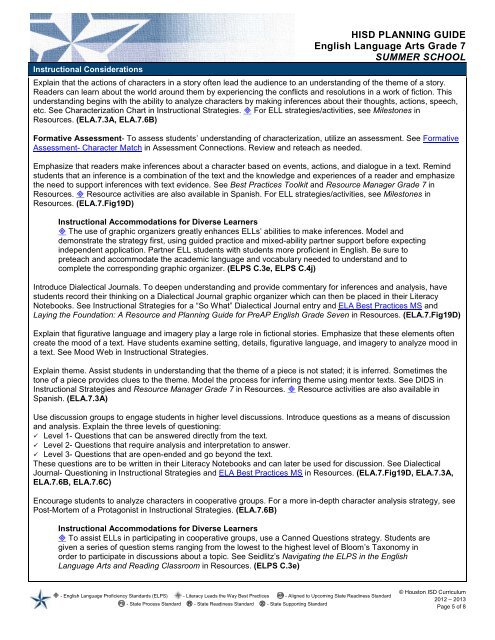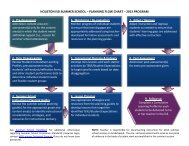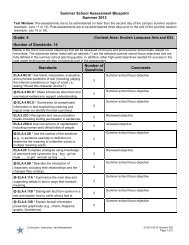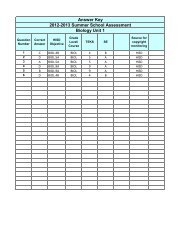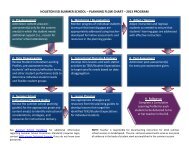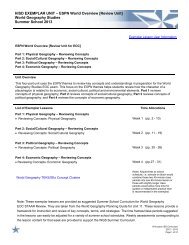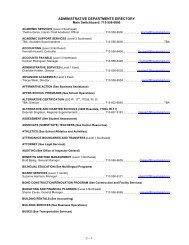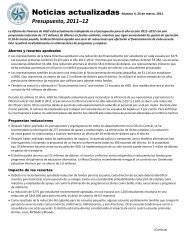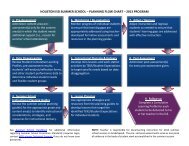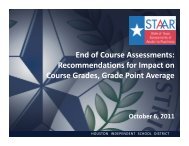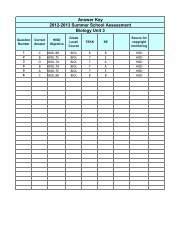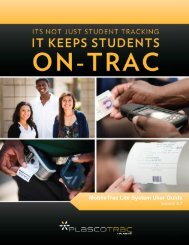SSK Unit 4.2 Planning Guide
SSK Unit 4.2 Planning Guide
SSK Unit 4.2 Planning Guide
- No tags were found...
Create successful ePaper yourself
Turn your PDF publications into a flip-book with our unique Google optimized e-Paper software.
Instructional ConsiderationsHISD PLANNING GUIDEEnglish Language Arts Grade 7SUMMER SCHOOLExplain that the actions of characters in a story often lead the audience to an understanding of the theme of a story.Readers can learn about the world around them by experiencing the conflicts and resolutions in a work of fiction. Thisunderstanding begins with the ability to analyze characters by making inferences about their thoughts, actions, speech,etc. See Characterization Chart in Instructional Strategies. For ELL strategies/activities, see Milestones inResources. (ELA.7.3A, ELA.7.6B)Formative Assessment- To assess students’ understanding of characterization, utilize an assessment. See FormativeAssessment- Character Match in Assessment Connections. Review and reteach as needed.Emphasize that readers make inferences about a character based on events, actions, and dialogue in a text. Remindstudents that an inference is a combination of the text and the knowledge and experiences of a reader and emphasizethe need to support inferences with text evidence. See Best Practices Toolkit and Resource Manager Grade 7 inResources. Resource activities are also available in Spanish. For ELL strategies/activities, see Milestones inResources. (ELA.7.Fig19D)Instructional Accommodations for Diverse Learners The use of graphic organizers greatly enhances ELLs’ abilities to make inferences. Model anddemonstrate the strategy first, using guided practice and mixed-ability partner support before expectingindependent application. Partner ELL students with students more proficient in English. Be sure topreteach and accommodate the academic language and vocabulary needed to understand and tocomplete the corresponding graphic organizer. (ELPS C.3e, ELPS C.4j)Introduce Dialectical Journals. To deepen understanding and provide commentary for inferences and analysis, havestudents record their thinking on a Dialectical Journal graphic organizer which can then be placed in their LiteracyNotebooks. See Instructional Strategies for a “So What” Dialectical Journal entry and ELA Best Practices MS andLaying the Foundation: A Resource and <strong>Planning</strong> <strong>Guide</strong> for PreAP English Grade Seven in Resources. (ELA.7.Fig19D)Explain that figurative language and imagery play a large role in fictional stories. Emphasize that these elements oftencreate the mood of a text. Have students examine setting, details, figurative language, and imagery to analyze mood ina text. See Mood Web in Instructional Strategies.Explain theme. Assist students in understanding that the theme of a piece is not stated; it is inferred. Sometimes thetone of a piece provides clues to the theme. Model the process for inferring theme using mentor texts. See DIDS inInstructional Strategies and Resource Manager Grade 7 in Resources. Resource activities are also available inSpanish. (ELA.7.3A)Use discussion groups to engage students in higher level discussions. Introduce questions as a means of discussionand analysis. Explain the three levels of questioning: Level 1- Questions that can be answered directly from the text. Level 2- Questions that require analysis and interpretation to answer. Level 3- Questions that are open-ended and go beyond the text.These questions are to be written in their Literacy Notebooks and can later be used for discussion. See DialecticalJournal- Questioning in Instructional Strategies and ELA Best Practices MS in Resources. (ELA.7.Fig19D, ELA.7.3A,ELA.7.6B, ELA.7.6C)Encourage students to analyze characters in cooperative groups. For a more in-depth character analysis strategy, seePost-Mortem of a Protagonist in Instructional Strategies. (ELA.7.6B)Instructional Accommodations for Diverse Learners To assist ELLs in participating in cooperative groups, use a Canned Questions strategy. Students aregiven a series of question stems ranging from the lowest to the highest level of Bloom’s Taxonomy inorder to participate in discussions about a topic. See Seidlitz’s Navigating the ELPS in the EnglishLanguage Arts and Reading Classroom in Resources. (ELPS C.3e) - English Language Proficiency Standards (ELPS) - Literacy Leads the Way Best Practices - Aligned to Upcoming State Readiness Standard- State Process Standard R - State Readiness Standard S - State Supporting Standard© Houston ISD Curriculum2012 – 2013Page 5 of 8


